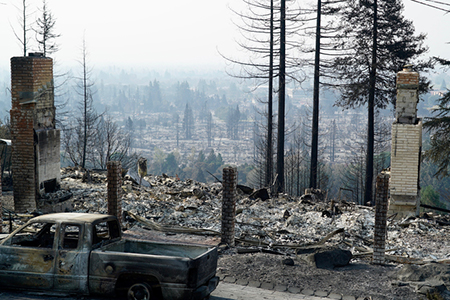It has taken weeks to tackle the most deadly and destructive wildfires in California history, a series of fiery eruptions now being called the October Fire Siege. Since the first outbreak on Oct. 8, Northern California has seen a total of 250 fires that burned over 245,000 acres and destroyed 8,900 structures. Forty-three deaths have been reported (as of Oct. 31), and the 100,000 evacuated residents are just now making their way back home. For some, that means returning to piles of ash and debris—a scene of complete desolation with only chimney structures enduring.
Only five active fires remained as of Oct. 31, which were handled by 1,000 firefighters—at the peak of destruction, 11,000 firefighters faced a total of 21 major fires at once. The devastating event prompted California Governor Edmund G. Brown Jr. to declare Oct. 28, 2017 a “Day of Remembrance of the Northern California Fires.”
“On this Day of Remembrance, I have ordered that flags be flown at half-staff over the State Capitol,” said Brown in a statement. “As we mourn for those we have lost, let us dedicate ourselves first to the aid of the survivors and then to the causes of safety and preparedness in our increasingly fire-prone state.”
Relief efforts are underway, and residents are looking to the government for financial assistance, as well. Over 3,000 fire victims have applied for individual assistance from the Federal Emergency Management Agency (FEMA), which has provided displaced Californians with $6 million in rental funds and other aid. In addition, the California Fire Foundation is providing financial assistance to victims through its Supplying Aid to Victims of Emergency (SAVE) program.
Real estate brokerages and lending institutions are coming together to help the affected communities, as well. Keller Williams is using its charitable arm, KW Cares, to provide donations and financial assistance to real estate agents impacted by the tragic fires. Wells Fargo has contributed a total of $1 million to relief efforts through the Red Cross, Salvation Army and local non-profits that will help with rebuilding efforts.
“These fires continue to rip an unimaginable path of destruction through communities throughout California, and we in turn are strengthening our commitment to those who have been affected,” said Tim Sloan, CEO and president of Wells Fargo, in a statement. “Our hearts and our commitment to help go out to all those who have lost their loved ones, homes and livelihoods as a result of this tragedy—some of whom are Wells Fargo team members.”
The future of real estate in these areas is still unclear, and government declarations have halted transactions even for homes that were unaffected by the fires.
The Federal Housing Authority is enforcing mandatory damage inspections for all homes in Presidentially-declared disaster areas, including Butte, Lake, Mendocino, Napa, Nevada, Orange, Sonoma and Yuba counties, before lenders can give out loans. This is stalling escrow, refinances and reverse mortgages.
Other government institutions are easing restrictions to accommodate for delays from fire damage and evacuations.
The Department of Housing and Urban Development (HUD) is granting immediate foreclosure relief: a 90-day suspension on foreclosures of FHA-insured home mortgages.Fannie Mae and Freddie Mac have enacted similar policies. These will delay foreclosure for tens of thousands of homeowners.
HUD is also offering forbearance and loan modification options. Borrowers from FHA-approved lenders may be eligible for 100 percent financing, including closing costs, through FHA insurance (HUD’s Section 203(h) program). Meanwhile, HUD’s Section 203(k) loan programs allow homeowners whose homes were destroyed to finance the purchase of a new home. Those with damaged homes can refinance the rebuilding or repair of an existing single-family home, as well.
Representatives in the affected towns are working together with the Environmental Protection Agency (EPA) to ensure that homes are safe for re-entry. The EPA is searching residential properties in the Coffey Park, Soda Canyon and Silverado neighborhoods for hazardous waste, corrosive or toxic materials and products that can catch fire or explode, which require special disposal methods.
The already tight inventory in California will pose a problem when it comes to finding new homes for the displaced population.
“While it’s encouraging that statewide home sales improved both monthly and annually, the year-over-year sales rate is losing steam, reflecting the persistent shortage of homes for sale and an easing of concern over a surge in mortgage rates,” said Geoff McIntosh, president of the California Association of REALTORS® (C.A.R.), referencing C.A.R.’s September sales report. “Additionally, for the areas that have been affected by the recent wildfires, we anticipate sales will pull back in those regions as damages are assessed and replacement efforts are coordinated.”
Liz Dominguez is RISMedia’s associate content editor. Email her your real estate news ideas at ldominguez@rismedia.com.
For the latest real estate news and trends, bookmark RISMedia.com.











